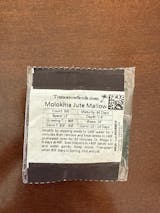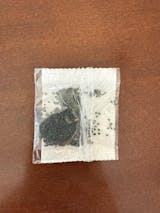
Molokhia (Egyptian Spinach)
$3.95
100%
Non-GMO
Free
Shipping
Service
Guaranteed
Also Known As: Corchorus Olitorius, Egyptian Spinach, Jute Mallow, Jew's Mallow, Nalta, Saluyot, Egyptian Spinach, Jute Mallow, Nalta Jute, Saluyot, Bush Okra, West African Sorrel, Jute Leaf, Crain-Crain, Mulukhiyah, Molokheyya, Molokhia, Mulukhiyyah, Mloukhieh, Meloukia, Moroheiya, Molohiya.
| Plant Name: | Molokhia |
| Latin Name: | Corchorus olitorius |
| Days to Germinate: | 10-21 |
| Days to Harvest: | 60 |
| Plant Height: | 3 - 5 Feet |
| Spread: | 2 - 3 Feet |
| Growth Habit: | Bush |
| USDA Zones: | 5-11 |
| Lifespan: | Annual |
| Brand: | TomorrowSeeds |
| Sunlight: | Full Sun, Partial Shade |
| Pollination: | Heirloom, Open-Pollinated |
| GMO: | No |
| Fungicide-Treated Seeds*: | No |
| Seeds Packed For**: | 2025 |
**Seeds are freshly packed for the growing season of the year listed. Seeds are still viable beyond pack date. Store in a cool and dry location such as the refrigerator or basement to best preserve germination rates.
Planting Instructions:
Soil Preparation:
Choose an area with heavy, well-draining soil that receives at least 6 hours of sunlight each day. Remove weeds, large rocks, and litter from the planting area. Leave small weeds and dead grass, they will enrich the soil when turned under. Spade or till the soil 8-12 inches deep. Loosening the soil will help the plant establish strong roots.
Plants grow best in soil with lots of organic matter. You may optionally add fertilizer or organic material such as compost, leaves, or rotted hay to mix into the soil at this point. For small gardens, scatter 2-3 tablespoons of fertilizer evenly and work into the top 2-3 inches of soil for each hill or 2 foot by 2 foot planting area. For larger gardens, scatter 2-3 pounds of a complete fertilizer for each 100 square feet of planting area. Work fertilizer or organic material into the soil and leave the surface smooth.
Form rows of soil beds 4-6 inches high and at least 2 feet apart. This formation of ridges will help with drainage.
Planting:
Molokhia thrives in warm temperatures, growing best between 70F and 85F . For best germination of Molokhia seeds, pre-chill seeds at 40F for 4 days, then germinate seeds in moist filter paper in a 95F environment, with the help of a heat mat or home incubator, before sowing.Starting Indoors: For earlier blooms, you may optionally start planting indoors in containers 6-8 weeks before the last expected frost date in Spring, keeping seedlings at least 65F. Harden off then transplant seedlings outdoors in a sunny location when temperatures are consistently above 60F. To transplant seedlings, prepare a transplant hole outdoors in a sunny location. Remove the plants carefully from the pots or flats and set them in the transplant holes, burying some of the stem in the ground. Pack the soil loosely around the plant and leave a slightly sunken area around each plant to hold water. Water the plants after transplanting.
Directly Sowing: If directly sowing outdoors, plant in spring after all danger of frost has passed and the soil warms to at least 60F. Fall planting is not recommended unless planting outdoors in environments with mild, frost-free winters, or planting indoors with supplemental grow lights. If Fall planting, sow in containers at least 10 weeks before the first frost and prepare to bring plants indoors if temperatures are colder than ideal.
To plant, make holes 1/2 inch deep and spaced 2 feet apart down the rows of raised beds. Plant 2-3 seeds per hole, then cover thinly with soil. Water after planting.
| Planting Depth: | 1/2 inch |
| Within-Row Spacing: | 2 feet |
| Between-Row Spacing: | 2-3 feet |
Care During the Season:
Watering: Water the plants deeply, soaking the soil to a depth of 6-8 inches, once a week. If there is no rainfall, water 2-3 times a week. Sandy soils may need to be watered more often than heavy clay soils.
Weeding: Keeping plants weed-free improves production. If plowing or hoeing, do not dig to deeply to prevent from cutting the feeder roots.
Fertilizing: Molokhia does not require frequent fertilization. If leaves are smaller than expected, you may optionally apply a light dressing of a complete fertilizer, without letting the fertilizer touch the plants. Water plants after fertilizing.
Insecticides: Insecticides may be used to protect plants. Bt-based insecticides and sulfur are organic options that can be used for prevention. Sulfur also has fungicidal properties and helps in controlling many diseases. Before using a pesticide, read the label and follow cautions, warnings and directions.
Diseases: If spots or mold appear, treat plants with an approved fungicide. Neem oil, sulfur, and other fungicides may be used. When using fungicides always follow label directions.
Harvesting:
To harvest Molokhia, cut the top shoots or individual leaves when they are young and tender, typically around 8 to 12 inches long, about 4 to 6 weeks after transplanting. This can be done by hand, either by plucking individual leaves or cutting the entire shoot. For continuous growth, repeat the harvesting every 2 to 3 weeks to encourage the plant to produce new leaves. If you prefer a harvest for jute production, cut the plant at ground level when it reaches 12 to 16 inches tall, just before fruit development begins. For the highest quality leaves, harvest early in the morning.

















